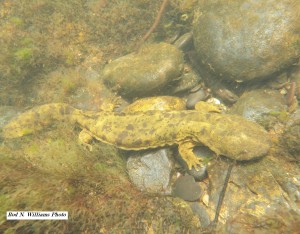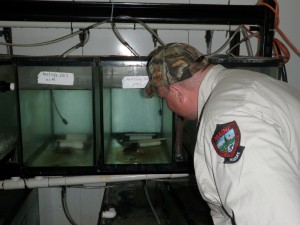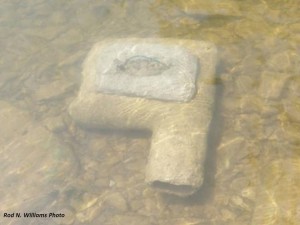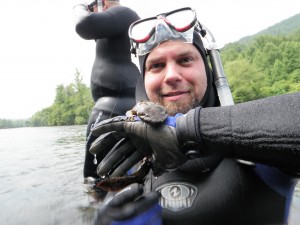June 11, 2015 at 12:45 pm
Recently, I traveled to Indiana and spent time at my Alma Mater – Purdue University and visited with a former classmate and life-long friend Dr. Rod Williams. Rod is conducting some pretty interesting work with an endangered salamander – the Eastern Hellbender, also known as the Devil Dog.
[caption id="attachment_703" align="alignright" width="430"] Adult Hellbender -- Photo by Dr. Rod Williams[/caption]
If you happened to be swimming in a river in the Midwest and came across this critter you would see how it earned its name.This is one of North America’s largest salamanders, which can grow to nearly 2 feet long and live to almost 30 years old.This animal breathes through its skin, so it has long skin-folds along its abdomen that resemble lasagna. It typically hides under large rocks during the day, and comes out at night to feed on crayfish so it has little bitty eyes. Regardless of the Hellbenders appearance, it was pretty cool to see this animal in person. To put this in perspective, a Hellbender is about 8 times the size of the, eastern newt, a species that probably most Mainers are familiar with (whether you know it or not).
This species likely never occurred in Maine, but in states where it does occur, like Indiana, Hellbender populations have been steadily declining. Like many declining aquatic species, Hellbenders are very sensitive to disturbance to their riverine habitat; they require clean and well-oxygenated water to thrive. Recent research has suggested that most of Indiana’s Hellbenders are geriatric and living spatially isolated from each other in the few remaining drainages that support them. This results in limited opportunities to “hook-up” and produce offspring.
Dr. Williams’ current work involves captive rearing and translocation of animals to supplement these declining populations. I was able to visit the captive rearing facility and handle a few of the animals in person.
[caption id="attachment_705" align="alignleft" width="328"]
Adult Hellbender -- Photo by Dr. Rod Williams[/caption]
If you happened to be swimming in a river in the Midwest and came across this critter you would see how it earned its name.This is one of North America’s largest salamanders, which can grow to nearly 2 feet long and live to almost 30 years old.This animal breathes through its skin, so it has long skin-folds along its abdomen that resemble lasagna. It typically hides under large rocks during the day, and comes out at night to feed on crayfish so it has little bitty eyes. Regardless of the Hellbenders appearance, it was pretty cool to see this animal in person. To put this in perspective, a Hellbender is about 8 times the size of the, eastern newt, a species that probably most Mainers are familiar with (whether you know it or not).
This species likely never occurred in Maine, but in states where it does occur, like Indiana, Hellbender populations have been steadily declining. Like many declining aquatic species, Hellbenders are very sensitive to disturbance to their riverine habitat; they require clean and well-oxygenated water to thrive. Recent research has suggested that most of Indiana’s Hellbenders are geriatric and living spatially isolated from each other in the few remaining drainages that support them. This results in limited opportunities to “hook-up” and produce offspring.
Dr. Williams’ current work involves captive rearing and translocation of animals to supplement these declining populations. I was able to visit the captive rearing facility and handle a few of the animals in person.
[caption id="attachment_705" align="alignleft" width="328"] Eastern Hellbender captive rearing facility at Purdue University.[/caption]
Dr. Williams calls this phase of the project “head-starting” because the animals are raised until 2-3 years old in an environment that has clean water, adequate food resources, and is free from predators, affording this vulnerable salamander the best chance for survival in the wild. Of course, while they are being given the “free ride” at Williams’ facility, his crew is conducting additional research on water flow regimes and animal behavior. These experiments will be testing biologists' ability to “condition” these young salamanders to threats and pathogens they’ll face once released back into the wild.
Once these large salamanders are ready to be released into the wild, Williams’ crew along with Indiana Department of Natural Resources and Indiana Department of Environmental Management select suitable release sites within the hellbender’s natural range. In order for the animal have the best chance of avoiding predators upon release, Dr. Williams utilizes some really cool artificial nest chambers.
[caption id="attachment_706" align="alignright" width="371"]
Eastern Hellbender captive rearing facility at Purdue University.[/caption]
Dr. Williams calls this phase of the project “head-starting” because the animals are raised until 2-3 years old in an environment that has clean water, adequate food resources, and is free from predators, affording this vulnerable salamander the best chance for survival in the wild. Of course, while they are being given the “free ride” at Williams’ facility, his crew is conducting additional research on water flow regimes and animal behavior. These experiments will be testing biologists' ability to “condition” these young salamanders to threats and pathogens they’ll face once released back into the wild.
Once these large salamanders are ready to be released into the wild, Williams’ crew along with Indiana Department of Natural Resources and Indiana Department of Environmental Management select suitable release sites within the hellbender’s natural range. In order for the animal have the best chance of avoiding predators upon release, Dr. Williams utilizes some really cool artificial nest chambers.
[caption id="attachment_706" align="alignright" width="371"] Artificial Rock Den for Eastern Hellbender -- Photo by Dr. Rod Williams[/caption]
These chambers or formed out of concrete and wire mesh and have a large enough opening in the front to allow the Hellbender access in and out of the chamber, but to keep out larger predators, such as river otters. The chamber can also be opened at the top to allow Dr. Williams’ researchers easy access for re-capturing the animal, to check for reproduction, or evacuating unwelcome guests, like catfish. Dr. Williams’ lab is currently rearing 235 juvenile hellbenders from eggs originally collected from these artificial nest chambers.
Hopefully, this program will help restore Eastern Hellbender populations in Indiana and elsewhere in their range.
[caption id="attachment_707" align="alignright" width="379"]
Artificial Rock Den for Eastern Hellbender -- Photo by Dr. Rod Williams[/caption]
These chambers or formed out of concrete and wire mesh and have a large enough opening in the front to allow the Hellbender access in and out of the chamber, but to keep out larger predators, such as river otters. The chamber can also be opened at the top to allow Dr. Williams’ researchers easy access for re-capturing the animal, to check for reproduction, or evacuating unwelcome guests, like catfish. Dr. Williams’ lab is currently rearing 235 juvenile hellbenders from eggs originally collected from these artificial nest chambers.
Hopefully, this program will help restore Eastern Hellbender populations in Indiana and elsewhere in their range.
[caption id="attachment_707" align="alignright" width="379"] Dr. Rod Williams with an Adult Eastern Hellbender[/caption]
For more information or to see how you can help the Hellbender visit:
www.helpthehellbender.org
or Dr. Williams’ homepage:
https://ag.purdue.edu/fnr/Pages/Profile.aspx?strAlias=rodw&intDirDeptID=15
Dr. Rod Williams with an Adult Eastern Hellbender[/caption]
For more information or to see how you can help the Hellbender visit:
www.helpthehellbender.org
or Dr. Williams’ homepage:
https://ag.purdue.edu/fnr/Pages/Profile.aspx?strAlias=rodw&intDirDeptID=15
 Adult Hellbender -- Photo by Dr. Rod Williams[/caption]
If you happened to be swimming in a river in the Midwest and came across this critter you would see how it earned its name.This is one of North America’s largest salamanders, which can grow to nearly 2 feet long and live to almost 30 years old.This animal breathes through its skin, so it has long skin-folds along its abdomen that resemble lasagna. It typically hides under large rocks during the day, and comes out at night to feed on crayfish so it has little bitty eyes. Regardless of the Hellbenders appearance, it was pretty cool to see this animal in person. To put this in perspective, a Hellbender is about 8 times the size of the, eastern newt, a species that probably most Mainers are familiar with (whether you know it or not).
This species likely never occurred in Maine, but in states where it does occur, like Indiana, Hellbender populations have been steadily declining. Like many declining aquatic species, Hellbenders are very sensitive to disturbance to their riverine habitat; they require clean and well-oxygenated water to thrive. Recent research has suggested that most of Indiana’s Hellbenders are geriatric and living spatially isolated from each other in the few remaining drainages that support them. This results in limited opportunities to “hook-up” and produce offspring.
Dr. Williams’ current work involves captive rearing and translocation of animals to supplement these declining populations. I was able to visit the captive rearing facility and handle a few of the animals in person.
[caption id="attachment_705" align="alignleft" width="328"]
Adult Hellbender -- Photo by Dr. Rod Williams[/caption]
If you happened to be swimming in a river in the Midwest and came across this critter you would see how it earned its name.This is one of North America’s largest salamanders, which can grow to nearly 2 feet long and live to almost 30 years old.This animal breathes through its skin, so it has long skin-folds along its abdomen that resemble lasagna. It typically hides under large rocks during the day, and comes out at night to feed on crayfish so it has little bitty eyes. Regardless of the Hellbenders appearance, it was pretty cool to see this animal in person. To put this in perspective, a Hellbender is about 8 times the size of the, eastern newt, a species that probably most Mainers are familiar with (whether you know it or not).
This species likely never occurred in Maine, but in states where it does occur, like Indiana, Hellbender populations have been steadily declining. Like many declining aquatic species, Hellbenders are very sensitive to disturbance to their riverine habitat; they require clean and well-oxygenated water to thrive. Recent research has suggested that most of Indiana’s Hellbenders are geriatric and living spatially isolated from each other in the few remaining drainages that support them. This results in limited opportunities to “hook-up” and produce offspring.
Dr. Williams’ current work involves captive rearing and translocation of animals to supplement these declining populations. I was able to visit the captive rearing facility and handle a few of the animals in person.
[caption id="attachment_705" align="alignleft" width="328"] Eastern Hellbender captive rearing facility at Purdue University.[/caption]
Dr. Williams calls this phase of the project “head-starting” because the animals are raised until 2-3 years old in an environment that has clean water, adequate food resources, and is free from predators, affording this vulnerable salamander the best chance for survival in the wild. Of course, while they are being given the “free ride” at Williams’ facility, his crew is conducting additional research on water flow regimes and animal behavior. These experiments will be testing biologists' ability to “condition” these young salamanders to threats and pathogens they’ll face once released back into the wild.
Once these large salamanders are ready to be released into the wild, Williams’ crew along with Indiana Department of Natural Resources and Indiana Department of Environmental Management select suitable release sites within the hellbender’s natural range. In order for the animal have the best chance of avoiding predators upon release, Dr. Williams utilizes some really cool artificial nest chambers.
[caption id="attachment_706" align="alignright" width="371"]
Eastern Hellbender captive rearing facility at Purdue University.[/caption]
Dr. Williams calls this phase of the project “head-starting” because the animals are raised until 2-3 years old in an environment that has clean water, adequate food resources, and is free from predators, affording this vulnerable salamander the best chance for survival in the wild. Of course, while they are being given the “free ride” at Williams’ facility, his crew is conducting additional research on water flow regimes and animal behavior. These experiments will be testing biologists' ability to “condition” these young salamanders to threats and pathogens they’ll face once released back into the wild.
Once these large salamanders are ready to be released into the wild, Williams’ crew along with Indiana Department of Natural Resources and Indiana Department of Environmental Management select suitable release sites within the hellbender’s natural range. In order for the animal have the best chance of avoiding predators upon release, Dr. Williams utilizes some really cool artificial nest chambers.
[caption id="attachment_706" align="alignright" width="371"] Artificial Rock Den for Eastern Hellbender -- Photo by Dr. Rod Williams[/caption]
These chambers or formed out of concrete and wire mesh and have a large enough opening in the front to allow the Hellbender access in and out of the chamber, but to keep out larger predators, such as river otters. The chamber can also be opened at the top to allow Dr. Williams’ researchers easy access for re-capturing the animal, to check for reproduction, or evacuating unwelcome guests, like catfish. Dr. Williams’ lab is currently rearing 235 juvenile hellbenders from eggs originally collected from these artificial nest chambers.
Hopefully, this program will help restore Eastern Hellbender populations in Indiana and elsewhere in their range.
[caption id="attachment_707" align="alignright" width="379"]
Artificial Rock Den for Eastern Hellbender -- Photo by Dr. Rod Williams[/caption]
These chambers or formed out of concrete and wire mesh and have a large enough opening in the front to allow the Hellbender access in and out of the chamber, but to keep out larger predators, such as river otters. The chamber can also be opened at the top to allow Dr. Williams’ researchers easy access for re-capturing the animal, to check for reproduction, or evacuating unwelcome guests, like catfish. Dr. Williams’ lab is currently rearing 235 juvenile hellbenders from eggs originally collected from these artificial nest chambers.
Hopefully, this program will help restore Eastern Hellbender populations in Indiana and elsewhere in their range.
[caption id="attachment_707" align="alignright" width="379"] Dr. Rod Williams with an Adult Eastern Hellbender[/caption]
For more information or to see how you can help the Hellbender visit:
www.helpthehellbender.org
or Dr. Williams’ homepage:
https://ag.purdue.edu/fnr/Pages/Profile.aspx?strAlias=rodw&intDirDeptID=15
Dr. Rod Williams with an Adult Eastern Hellbender[/caption]
For more information or to see how you can help the Hellbender visit:
www.helpthehellbender.org
or Dr. Williams’ homepage:
https://ag.purdue.edu/fnr/Pages/Profile.aspx?strAlias=rodw&intDirDeptID=15